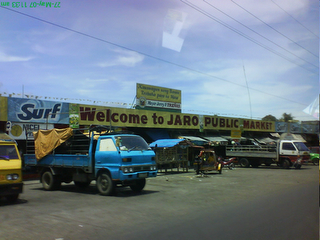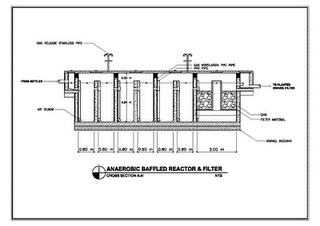Public Market Case Study
|
Editor's Note: Special thanks to engineers Danilo Dinson and Noen Gregorio of Iloilo City for their contributions to this project. Also thank you to the Bremen Overseas Research And Development Agency (BORDA) for some of the images presented below. We invite you to check back periodically to monitor the progress of Iloilo City as they implement this wastewater project for the Jaro Public Market. The Jaro Public Market, like most city markets in the Philippines, is complete with dry goods stalls such as those selling kitchen wares, secondhand goods (Ukay-Ukay stalls), fish and meat stalls, vegetable vendors and canteens. The Jaro market also has a coconut grinding and live animal section. In an effort to meet the requirements of the Clean Water Act and improve environmental and health conditions in the Jaro area, Iloilo City engineering and planning departments are developing a wastewater treatment system. |
Contents
Design Parameters
Determining an accurate design flow, or how much wastewater is generated at the facility, is a good starting point when designing a wastewater system. City engineers are estimating that the average flow from the Jaro market is 12 cubic meters per day. This is a good initial estimate and provides a baseline for further investigation and refinement for developing the design flow value. To determine an accurate design flow, engineers will verify water consumption figures from the water district. Because a wastewater system must be designed to accommodate peak flows, some estimates for converting the monthly water meter data to peak daily flow will be required. For example, if water meter data for a peak month is used, the value is divided by the number of days in the month and the result multiplied by a peaking factor. A peaking factor of 1.5 or 1.7 (the appropriate peaking factor is determined through local knowledge) will estimate peak flows from average flow data. This will also help to build in some margin of safety to ensure that the system will not be undersized. Engineers are working now to determine the proper peak flow number and identify the wastewater system design flow from which the detailed engineering designs will be based.
Proposed Wastewater System Components
Engineers are recommending that the wastewater system include the following components:
- Grease and trash traps located at key points in the sewer system to remove grease from the food service areas and heavy solids from the vegetable, meat and fish areas
- Settler - a settling tank, similar to a septic tank, to perform primary settling
- Anaerobic Baffled Reactor (ABR) - to remove much of the organic mater and suspended solids in the wastewater stream
|
This project will utilize an ABR with approximately 2.4 days of retention time to remove approximately 70% of the biochemical oxygen demands and total suspended solids in the wastewater stream. The specific design of the ABR tank has yet to be finalized. Engineers are considering using both a 5 and 7 chamber ABR design. They are currently consulting with their design team and subcontractors to determine the best ABR configuration for the project. Note that the final chamber of the ABR will include an upflow gravel filter, which will not only help remove suspended solids but will also help with biological treatment. The ABR, along with the upflow filter, will treat the effluent to a point that it may be discharged into the secondary treatment system, which in this case is a subsurface flow constructed wetlands. |
Secondary Treatment - Constructed Wetlands
The constructed wetlands, otherwise known as a planted gravel filter, will treat the wastewater to a point where it may be safely discharged in compliance with environmental standards. Wastewater from the ABR tank will flow through the inlet structure of the constructed wetlands where it will be evenly distributed through the gravel media. As this is a subsurface flow wetlands, all of the wastewater will be maintained below a layer of gravel and mulch.
There are several good examples of constructed wetlands systems for public markets. The photo provided here is from the BORDA-developed system at the Dumaguete Public Market. Constructed wetlands not only help treat wastewater, but they add aesthetic values as well. They may also be used to develop microenterprise projects through the sale of cut flowers or hydroponically growing saplings for the reforestation industry.
Cost Estimate
City engineers are developing a detailed cost estimate for the Jaro market wastewater project. Initial estimates are provided below:
| SUMMARY OF APPROXIMATE COST | ||
| in Philippine Pesos (P) | ||
| 1 | Grease Trap 1.00 m x 1.00 m x 1.00 | P 25,500.00 |
| 2 | Grit Chamber w/Bar Screen 1.00 m x 1.00 m x 1.50 m | P 35,000.00 |
| 3 | Septic Vault | P 85,000.00 |
| 4 |
Digestive Chamber:
|
|
| 5 |
Clarification Chamber:
|
|
| 6 | Concrete Manhole 1.00 m x 1.00 m | P 185,000.00 |
| 7 | Sewer Lines | P 250,000.00 |
| 8 | Storm Drain (w/manhole) | P 850,000.00 |
| 9 | Settler Tank 2.00 m x 6.20 m | P 136,400.00 |
| 10 | Anaerobic Baffled Reactor 5.00 m x 6.80 m | P 330,000.00 |
| 11 | Anaerobic Filter | P 137,500.00 |
| 12 | Planted Gravel Filter 7.00 m x 20.00 m | P 385,000.00 |
| 13 | Indicator Pond | P 38,500.00 |
Approximate Total Project Cost P 2,457,900.00
In addition to the project cost estimated above, the engineers will be preparing a cost recovery plan. This will be based upon how many stalls and how many pesos per stall should be calculated for a 3, 5 and 7 year cost recovery plan. Then the stall owners can decide how they want to proceed. Engineers and planners at the city staff will consider other options for financing as well. They may adopt the program of funding operations and maintenance through a public restroom user fee similar to the Dumaguete public market project, which uses the fees from the public restroom to fully fund the operations and maintenance for their market facility.
Finally, an operations and maintenance plan will be developed and associated costs calculated. Operations expenses are anticipated to be quite low as this is a passive wastewater system with no electrical requirements. Data on the operations and maintenance costs will be considered for the cost recovery plan.


